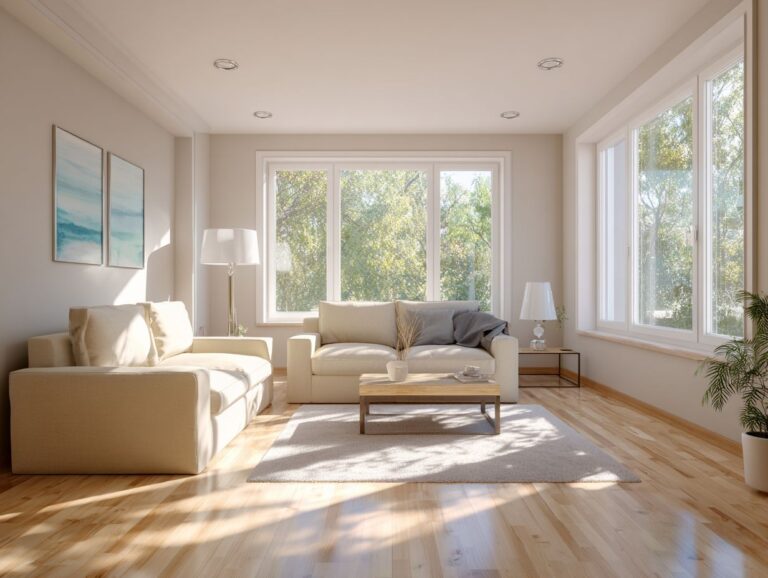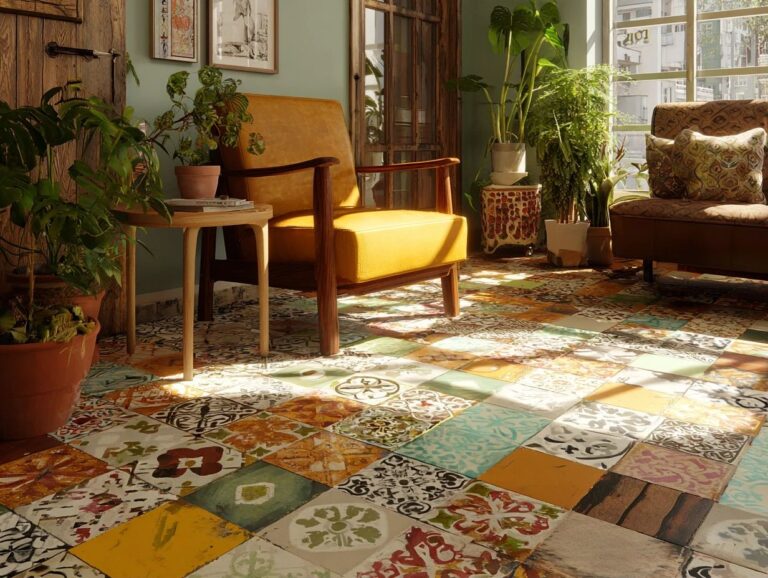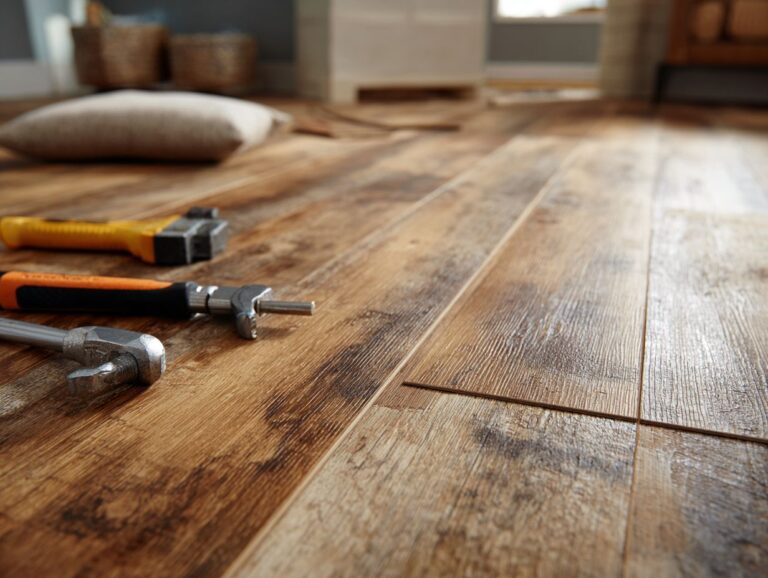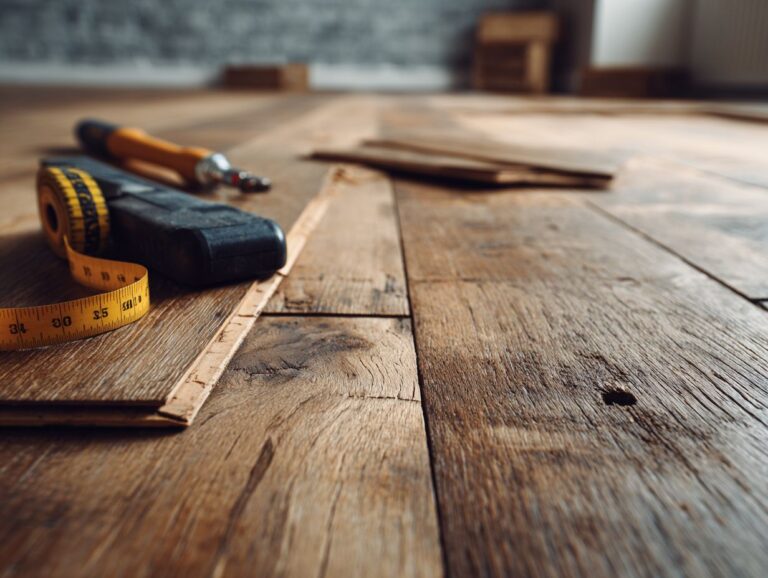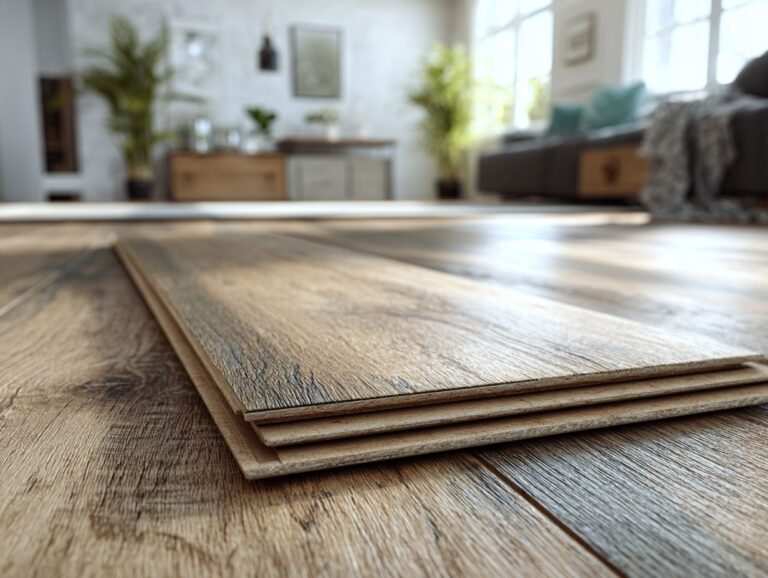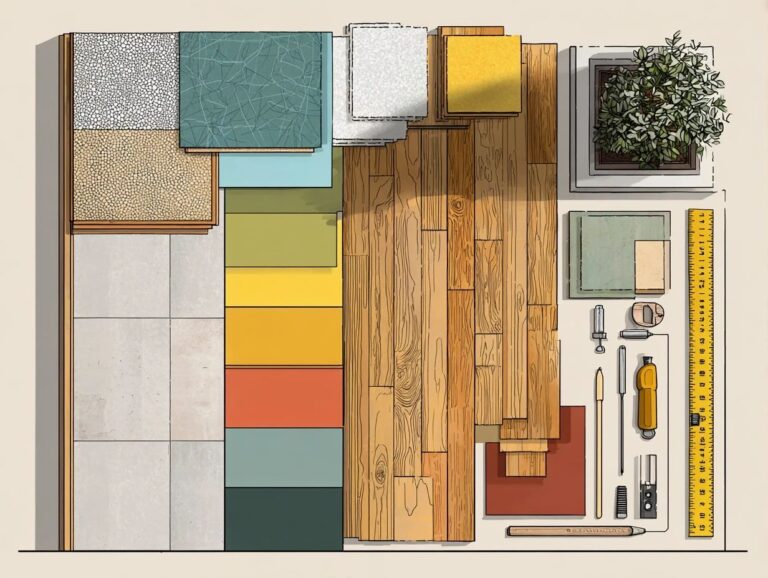Kitchen Flooring Options – Water Resistance and Style
Choosing kitchen flooring requires balancing appearance with the ability to resist water. Waterproof flooring options, such as luxury vinyl and ceramic tile, offer both durability and aesthetic appeal. Porcelain tile is a good choice for kitchen flooring because it looks great and can handle spills and moisture. In this article, we’ll look at different kitchen flooring choices that improve your space while still being practical.
Key Takeaways:
Contents
- Types of Kitchen Flooring Options
- Kitchen Flooring Market Statistics
- Global Flooring Market Projections: Market Value by Year
- Global Flooring Market Projections: Regional Revenue Share 2024
- Global Flooring Market Projections: Application Revenue Share 2024
- Vinyl Flooring Market Overview: Annual Market Value
- Hardwood Flooring
- Laminate Flooring
- Vinyl Flooring
- Ceramic and Porcelain Tile
- Natural Stone Flooring
- Concrete Flooring
- Water Resistance Ratings
- Style Considerations for Kitchen Flooring
- Maintenance and Longevity
- Cost Considerations
- Frequently Asked Questions
- What are the best kitchen flooring options for water resistance?
- Can hardwood flooring be a good option for a kitchen with water resistance?
- What are the benefits of choosing a water-resistant kitchen flooring option?
- What are the different styles available for water-resistant kitchen flooring?
- Are there any eco-friendly options for water-resistant kitchen flooring?
- Can I install water-resistant kitchen flooring myself, or do I need a professional?
Importance of Water Resistance in Kitchens
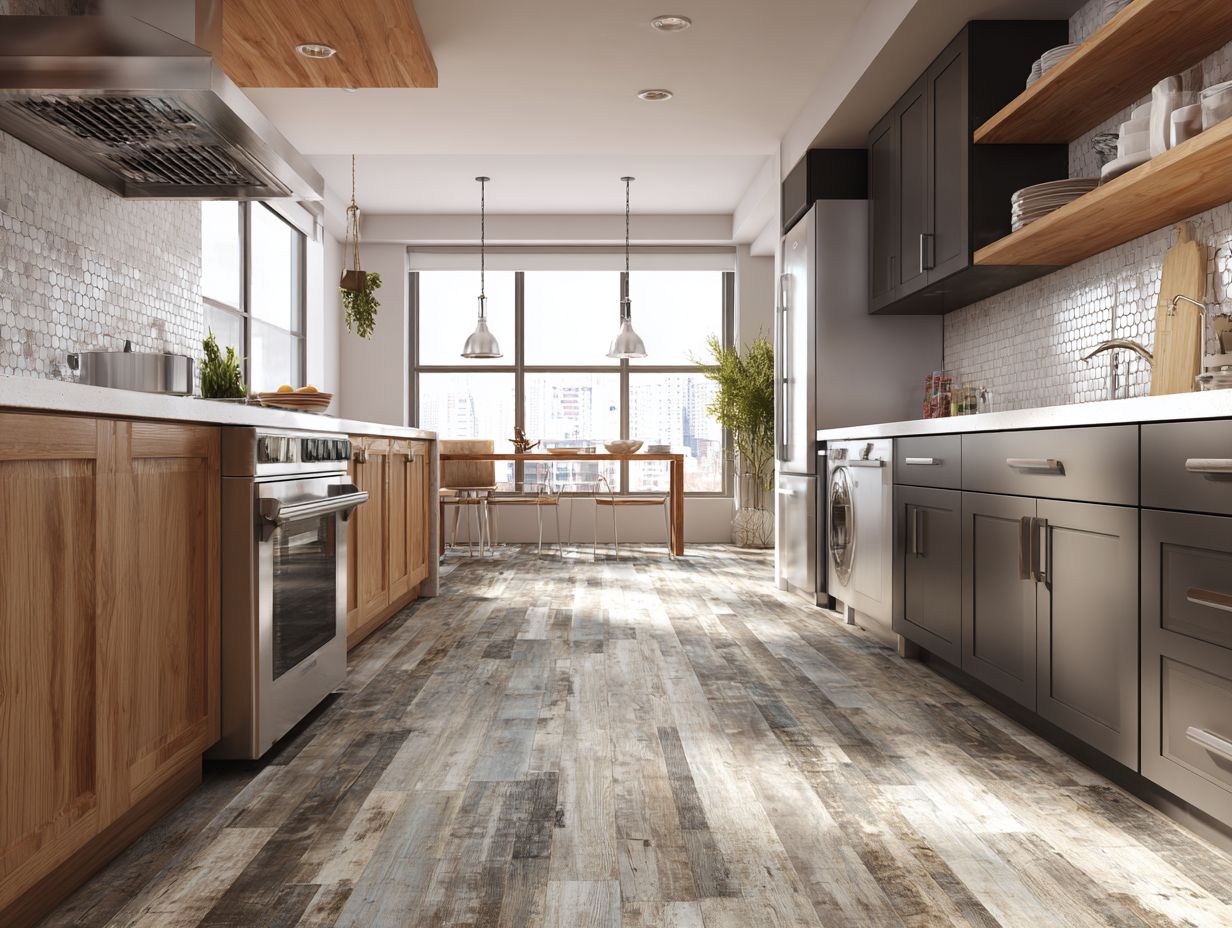
Because kitchens get a lot of use and often have moisture, it’s important to pick flooring that doesn’t get damaged by water to make it last longer and require less upkeep.
Kitchens often have humidity levels over 20%, so it’s important to choose materials that can last.
Luxury vinyl flooring is completely waterproof, simple to maintain, and can imitate expensive looks, which is why many homeowners prefer it. For those interested in exploring a variety of styles, consider the diverse vinyl flooring pattern options available, such as wood and stone looks.
Waterproof laminate also offers a stylish option, with added protection against spills and splashes. Ceramic tile provides excellent water resistance and is available in countless designs.
Choosing these materials improves the kitchen’s functionality and makes upkeep much easier.
Balancing Style and Functionality
To create an ideal kitchen floor, select strong materials that also match your home’s design and your personal taste.
Start by exploring a range of materials like hardwood, tile, and vinyl, each offering unique benefits.
For a cohesive look, consider using color schemes that reflect your kitchen’s overall palette. For example, matching light oak flooring with dark cabinets creates a noticeable difference.
Use design tools like Houzz to look at various kitchen styles, which can help you decide.
Choose finishes that are strong and match your decorations for both practical use and visual appeal.
Types of Kitchen Flooring Options
Selecting the best kitchen flooring requires knowing the pros and cons of different materials on the market.
Kitchen Flooring Market Statistics
Kitchen Flooring Market Statistics
Global Flooring Market Projections: Market Value by Year
Vinyl Flooring Market Overview: Annual Market Value
The Kitchen Flooring Market Statistics provides a detailed look at the worldwide flooring market and the vinyl flooring section, showing expected growth, revenue distribution by region, and application shares.
Global Flooring Market Projections reveal a significant expansion from a market size of $349.66 billion in 2024 to $652.38 billion by 2034. This growth, driven by a compound annual growth rate (CAGR) of 6.5% Between 2025 and 2034, there is a strong need for flooring products around the world, driven by construction and renovation trends.
- Regional Revenue Share: The Asia Pacific region commands a leading revenue share of 46.0% in 2024, reflecting its substantial contribution to the market fueled by rapid urbanization, economic growth, and high construction rates. Vitrified porcelain tiles represent 28.0% of this share, indicating their popularity due to durability and aesthetic appeal.
- Application Revenue Share: The market is evenly split between the residential segment at 50.0% and the commercial segment at 44.0%. This balance highlights the dual demand for flooring solutions across homes and commercial establishments, driven by the need for functional and stylish environments.
Vinyl Flooring Market Insights focus specifically on the vinyl segment, which is seeing rapid growth. The vinyl market is expected to grow from $36.63 billion in 2023 to $66.94 billion by 2032, with a CAGR of 6.8% from 2024 to 2032. This growth illustrates vinyl’s increasing popularity due to its versatility, cost-effectiveness, and ease of installation.
Overall, the data indicates a strong kitchen flooring market, with many chances in both home and business areas, and considerable growth in the vinyl flooring segment. This expansion is driven by consumer demand for high-quality, durable, and aesthetically pleasing flooring solutions.
Hardwood Flooring
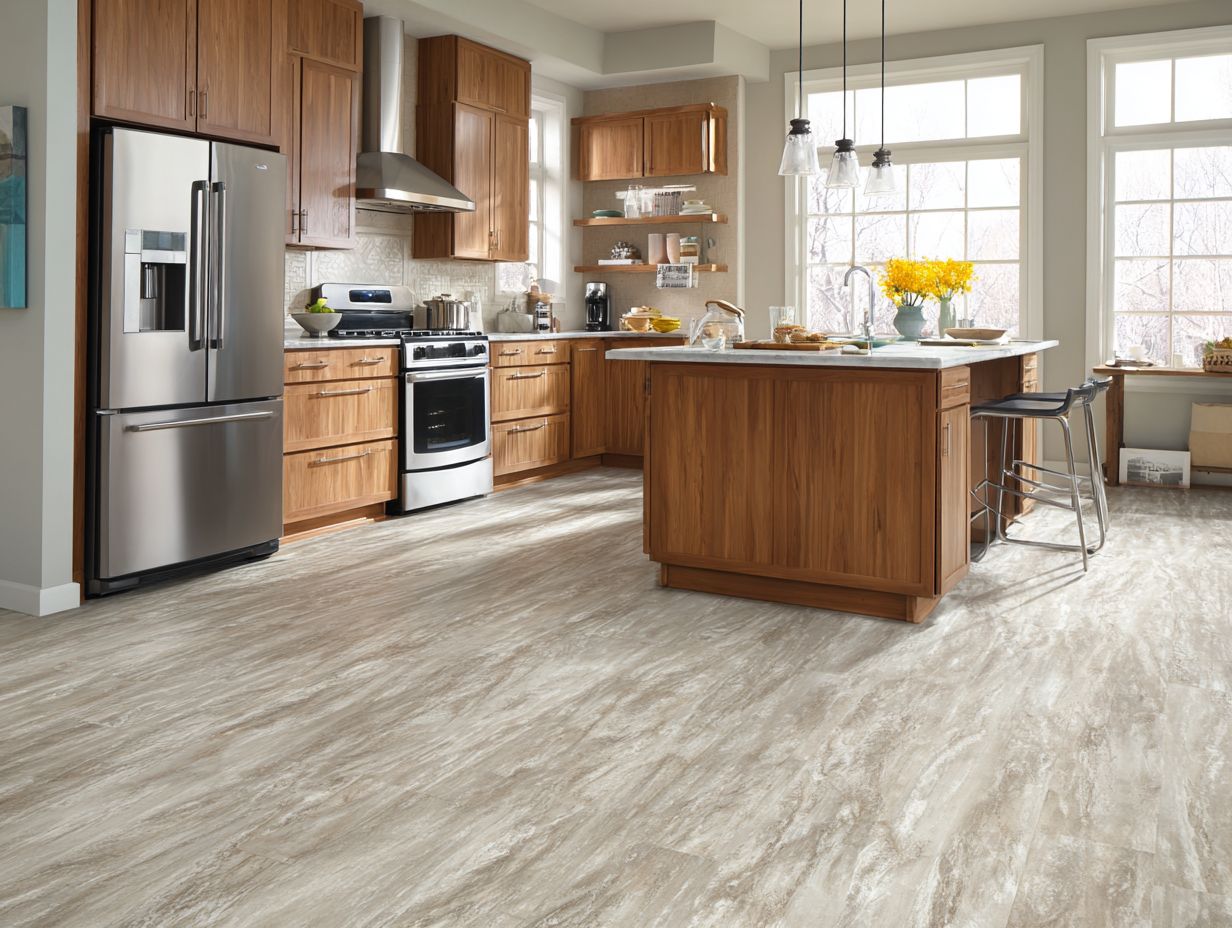
Hardwood flooring is renowned for its timeless elegance and comfort underfoot, providing a warm and inviting atmosphere for kitchens.
It requires careful consideration regarding moisture resistance and maintenance. For durable use, choose products like Coreluxe. It offers a waterproof option that looks nice, making it ideal for kitchens.
Tranquility has a strong surface that withstands scratches and spills. Regular maintenance involves sweeping or vacuuming to remove debris and periodic application of a wood floor cleaner to retain shine.
Use area rugs to protect busy areas, combining style and function to keep your floors in good condition.
Laminate Flooring
Laminate flooring offers a budget-friendly alternative to hardwood, combining stylish looks with practical water resistance features.
Among the growing trends in laminate options, waterproof laminate is increasingly popular. Brands like AquaGuard offer exceptional durability, with prices starting around $2.50/sq ft.
Another great choice is Pergo Extreme, known for its waterproof capabilities and stylish designs, priced around $3.00/sq ft. Consider also the DeSoto Floor Covering & Interiors, which provides options beginning at $1.50/sq ft.
These choices improve how your home looks and guard against moisture, making them perfect for kitchens and bathrooms.
Vinyl Flooring
Luxury vinyl flooring is praised for being tough and resisting water, which makes it a great option for kitchens that need easy-to-care-for floors.
Putting in COREtec vinyl is simple; you can install it in just one day, so homeowners experience less inconvenience.
In terms of cost, vinyl flooring generally ranges from $2 to $7 per square foot, including materials and installation.
The design options are vast, from realistic wood grains to colorful patterns, enabling a perfect match for any kitchen aesthetic.
Many products come with a warranty of up to 25 years, reinforcing their long-term value.
Ceramic and Porcelain Tile
Ceramic and porcelain tiles resist water well and offer a variety of styles, making them ideal for stylish kitchens where moisture is often present.
When deciding between ceramic and porcelain tiles for your kitchen, consider their price points and durability.
-
Ceramic tiles typically cost between $1 and $5 per square foot, making them a budget-friendly option for covering large spaces. They work well for wall applications and low-traffic areas.
-
Porcelain tiles, costing $3 to $10 per square foot, are strong and resist moisture. This makes them ideal for busy areas of the kitchen, such as floors or backsplashes.
Using porcelain with strong patterns can improve your kitchen’s look and make it last longer.
Natural Stone Flooring
Natural stone flooring, like granite and slate, is very beautiful and long-lasting. However, it requires more maintenance and care compared to fake options.
Granite is a popular choice for kitchens because it resists scratching and withstands heat, which makes it ideal for high-activity areas.
Slate, with its rich texture and color variations, provides a unique aesthetic but demands regular sealing to prevent staining. Maintenance typically involves cleaning with pH-neutral stone soap and periodic resealing-costs for which can range from $0.50 to $2.00 per square foot annually.
Consider options like polished marble for a luxurious look, though beware that it is more susceptible to scratches and etching.
Concrete Flooring
Concrete flooring is a strong option that allows for personalization. It can be finished with stains and coatings to increase water resistance and create a distinct appearance.
To improve your concrete flooring, think about using polished or stained finishes.
Polished concrete can range from $3 to $5 per square foot, providing a sleek, reflective surface perfect for modern spaces. Staining concrete costs around $2 to $6 per square foot and gives it color, making it good for both inside and outside areas.
Before you install, make sure the area is completely clean before applying stain or sealant. If you decide to polish it, talk to experts to get a smooth finish.
Water Resistance Ratings
Knowing about water resistance ratings is important for homeowners choosing flooring that can handle moisture and daily spills in kitchens.
Understanding Water Resistance Levels
Water resistance levels, often classified from 1 to 5, guide homeowners in selecting flooring that can handle moisture exposure effectively.
-
Level 1 indicates minimal resistance, suitable for dry areas like living rooms.
-
Level 2 is a bit better and can take care of small spills, so it’s good for kitchens.
-
Level 3 materials can withstand humidity but are not fully waterproof, ideal for bathrooms.
-
Level 4 offers significant moisture protection, often found in laundry rooms.
-
Level 5 is waterproof, perfect for areas prone to standing water, such as basements.
For example, waterproof laminate rated Level 5 features sealed edges and can handle pools of water without damage.
Comparing Water Resistance of Different Materials
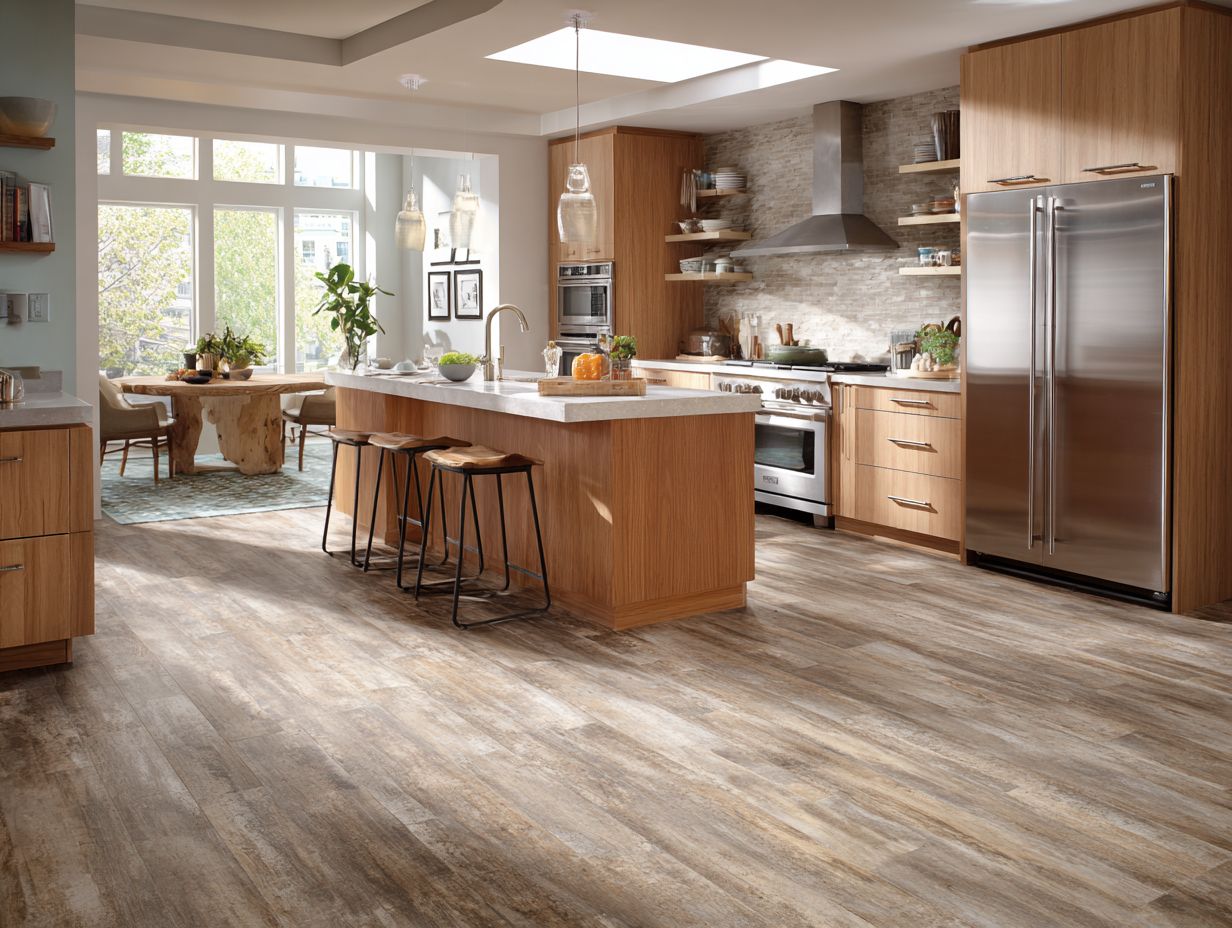
When comparing water resistance among various flooring materials, ceramic tiles often score highest for moisture protection, followed closely by luxury vinyl and laminate.
Ceramic tiles do not absorb water, which makes them a good choice for bathrooms and kitchens.
Luxury vinyl offers a good mix of looks and water resistance, ideal for basements and busy areas. Laminate, on the other hand, doesn’t resist water as well, so it’s best used in drier spaces.
In practice, ceramic tiles can withstand spills and cleaning agents without damage, while vinyl can endure moisture and temperature fluctuations.
Laminate, though more affordable, should be avoided in wet areas to prevent warping. Choosing the right material depends drastically on the space’s specific needs.
Style Considerations for Kitchen Flooring
Choosing kitchen flooring involves considering both practical use and style to improve the look of the area.
Color and Texture Options
The colors and textures you choose for your kitchen floor can greatly change the atmosphere and how large the space feels, providing many design options.
Lighter wood tones or white tiles can make a kitchen look brighter, helping smaller areas seem larger.
In contrast, dark slate or rich hardwood can create a warm, inviting atmosphere, perfect for larger spaces.
For added depth, consider using textured tiles like a rough stone finish that contrasts with smooth cabinetry, providing visual interest.
Adding colorful area rugs to your flooring selection can create a unified appearance, connecting all parts while outlining different working areas in your kitchen.
Patterns and Layouts
Using patterns and unique designs can make your kitchen floor more visually appealing, adding personality to the area.
To make a clear herringbone pattern, use materials like hardwood or quality vinyl tiles, ensuring each piece is cut at a 45-degree angle for accuracy.
Diagonal placements can be achieved with square tiles; just rotate them to create a sense of movement.
Experiment with contrasting grout colors to emphasize patterns or unify the floor’s design.
Tools such as a tile cutter and level will aid in installation, ensuring that your unique layout remains flawless and visually appealing.
Matching Flooring with Kitchen Design
Integrating your flooring choice with the overall kitchen design is essential to create a cohesive and inviting atmosphere.
For modern kitchens, consider sleek options like polished concrete or large-format tiles in neutral shades. Rustic styles pair beautifully with reclaimed wood or natural stone, emphasizing warmth and texture.
If you prefer traditional styles, classic hardwood or patterned ceramic tiles can improve the atmosphere.
To coordinate colors and finishes, create a color palette with swatches from your cabinetry and countertops, ensuring that your flooring complements these elements seamlessly. Apps like Paint Tester can show how different colors might look before you choose.
Maintenance and Longevity
Knowing how to care for your kitchen floor can greatly affect how long it lasts and how it looks as the years go by.
Cleaning and Care for Water-Resistant Floors
Regular cleaning and proper care for water-resistant floors can extend their lifespan significantly while keeping them looking new.
To maintain your water-resistant flooring effectively, use pH-neutral cleaners specifically designed for the material.
For vinyl floors, brands like Zep and Bona are excellent options; they clean without leaving residue. Always apply the cleaner with a microfiber mop, ensuring that you follow the manufacturer’s instructions for dilution.
For deeper cleaning, a mixture of vinegar and water can dissolve grime without damaging the surface. Avoid abrasive scrubbers, and always dry the floor afterward to prevent slips and moisture damage, ensuring your floors remain pristine over time.
Expected Lifespan of Different Flooring Types
Knowing the expected lifespan of different flooring types helps homeowners make informed decisions regarding their kitchen investments.
For example, with the right care, hardwood floors can last for 20-25 years, offering both durability and style. In contrast, laminate flooring typically endures 15-20 years, offering a budget-friendly alternative.
Vinyl, while economical, generally wears out in 10-20 years, depending on quality. Factors like foot traffic, humidity, and maintenance routines significantly influence these lifespans.
Regular cleaning and avoiding moisture accumulation can extend the life of your flooring, ensuring you enjoy your investment longer.
Cost Considerations
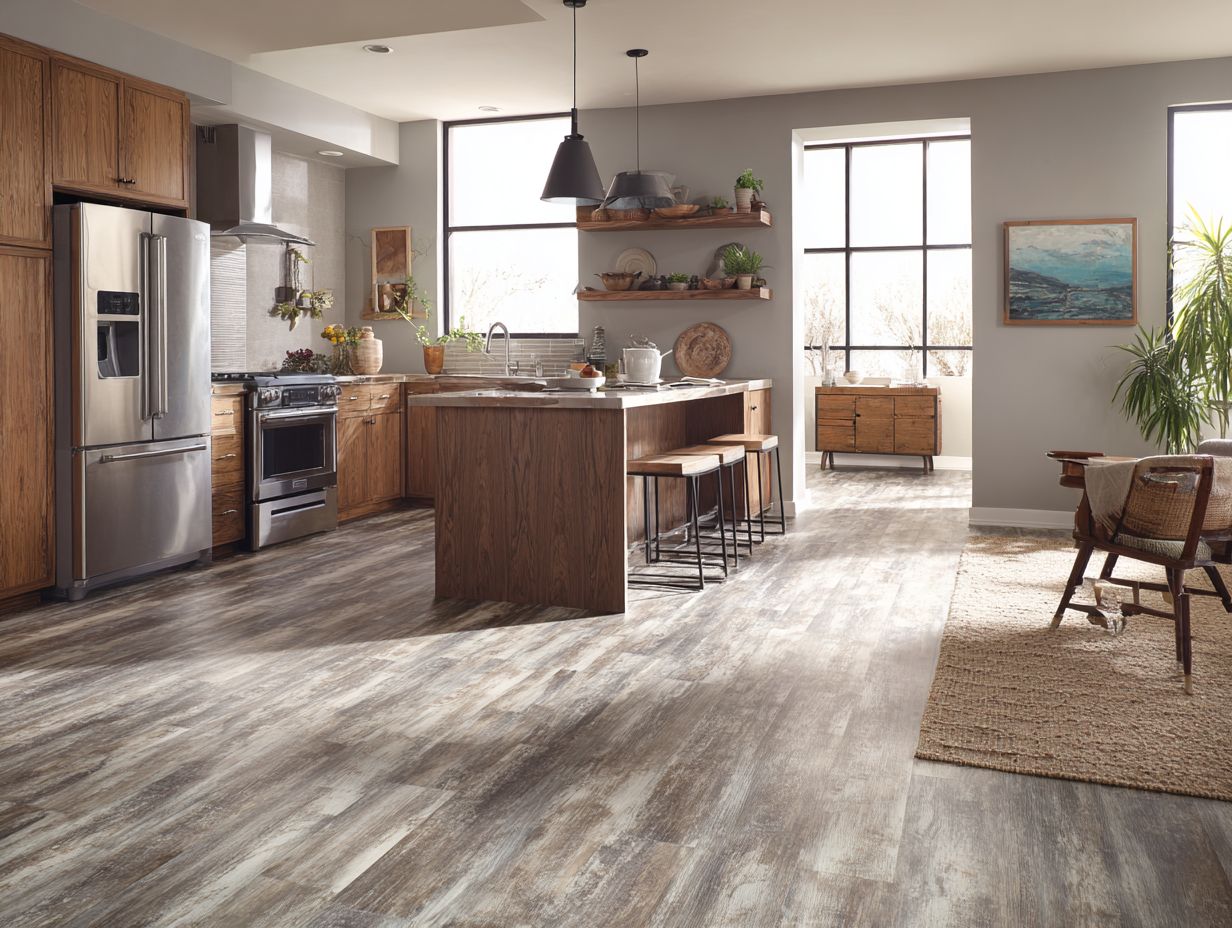
Planning your kitchen flooring budget helps you stay within your spending limits and choose materials that give you the most for your money.
Budgeting for Kitchen Flooring
Planning a budget for kitchen flooring means being aware of the costs of materials and installation to prevent spending too much.
To create a complete budget, think about these types of flooring:
- Laminate ranges from $1-$5 per square foot, offering a cost-effective option.
- Luxury vinyl, priced at $2-$8 per square foot, provides durability and water-resistance, ideal for kitchens.
- Hardwood can be more expensive, typically ranging from $5-$15 per square foot, and requires careful maintenance.
Factor in installation costs, which might add $2-$6 per square foot depending on complexity. Always allocate extra for underlayment or specialty trimming, ensuring a complete and polished look.
Cost vs. Value: Water Resistance and Style
Thinking about whether spending more on water-resistant flooring is a good decision is important for choosing something that looks nice and works well.
To effectively assess this, consider the long-term advantages offered by high-quality materials like COREtec vinyl. While its initial cost may be higher than cheaper alternatives, COREtec’s durability and ease of maintenance often translate to savings over time.
For example, unlike low-cost laminate, which can warp or stain easily, COREtec can withstand moisture without compromising its integrity. Picking quality flooring enhances your home’s appearance and helps you avoid spending money on repairs and replacements later, making it a wise long-term investment.
Final Thoughts on Choosing Kitchen Flooring
Your kitchen floor should fit your lifestyle, taste, and practical needs, so you will be satisfied with it for many years.
Consider factors like durability, maintenance, and style. For instance, ceramic tiles are water-resistant and easy to clean but can feel cold underfoot.
Hardwood offers warmth and aesthetic appeal, yet it requires regular care to prevent wear. Vinyl planks provide a budget-friendly option, mimicking the look of wood or stone while being resistant to spills.
Look into different flooring options to understand their benefits and drawbacks. Choose one that matches your kitchen’s design and suits your daily needs.
Frequently Asked Questions
What are the best kitchen flooring options for water resistance?
The most water-resistant flooring options for kitchens are tile, vinyl, and laminate. These materials are highly durable and can handle spills and moisture without warping or damage.
Can hardwood flooring be a good option for a kitchen with water resistance?
While hardwood flooring is not typically known for its water resistance, there are some options that can be used in kitchens. Engineered hardwood and bamboo are more water-resistant than traditional hardwood and can be a good choice for a kitchen.
What are the benefits of choosing a water-resistant kitchen flooring option?
A water-resistant floor for your kitchen can handle spills and moisture, which makes cleaning and upkeep simpler. It can also prevent damage to the subfloor and extend the lifespan of your flooring.
What are the different styles available for water-resistant kitchen flooring?
There are many styles available for water-resistant kitchen flooring, including tile that mimics the look of hardwood or stone, luxury vinyl that can replicate the appearance of natural materials, and laminate that comes in a variety of colors and patterns.
Are there any eco-friendly options for water-resistant kitchen flooring?
Yes, there are eco-friendly water-resistant flooring options for kitchens, such as bamboo, cork, and linoleum. These materials are sustainable and can handle water without warping or damage.
Can I install water-resistant kitchen flooring myself, or do I need a professional?
The installation of water-resistant kitchen flooring can vary depending on the material. While some options, like click-and-lock vinyl or laminate, can be DIY projects, others, such as tile, may require a professional for proper installation. It’s best to consult with a flooring expert to determine the best course of action for your specific flooring choice.
